This reviewer left such a thoughtful review, I feel they understood my objective.
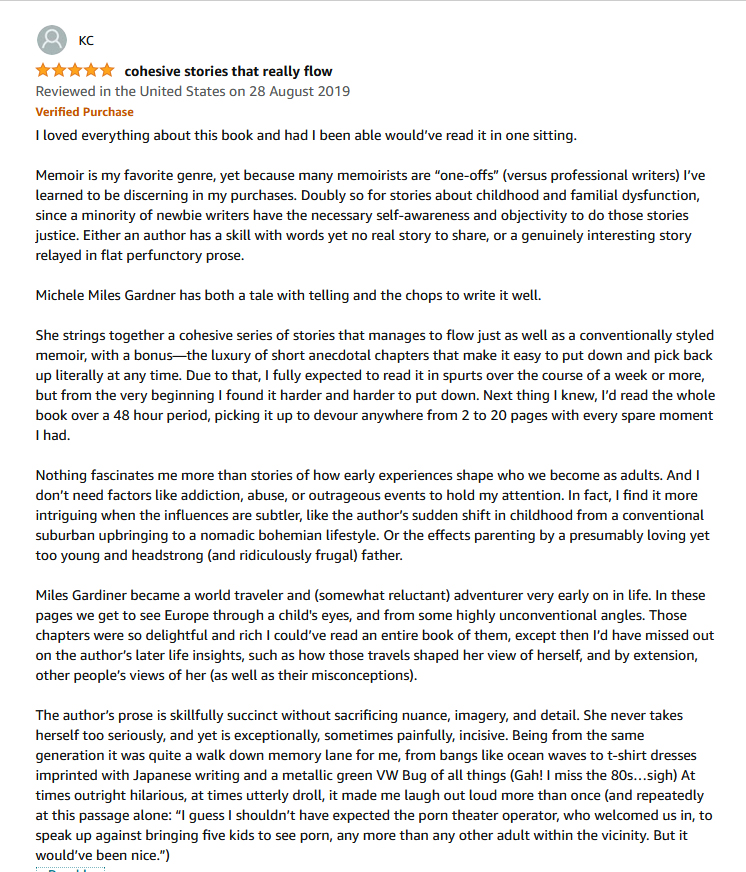
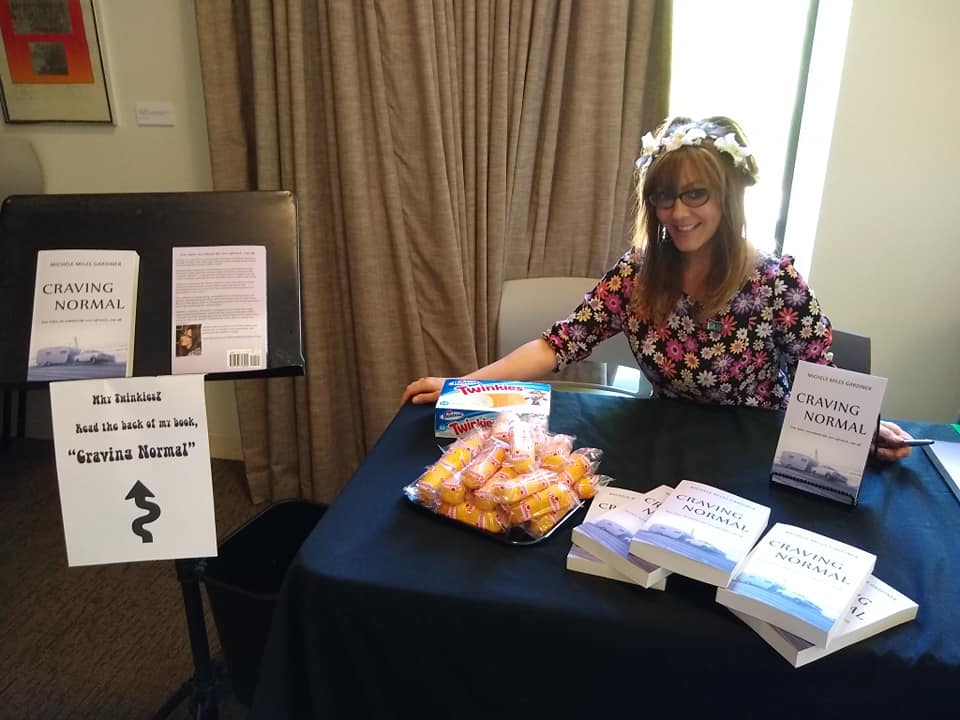
While promoting Craving Normal at the Brand Library in Glendale, I set up my books next to a tray of Twinkies. Below them, I put a sign saying, “Why Twinkies? Read the back of my book…” I did it as a “conversation starter.” I put that in quotes because the last time somebody used that term with me was when I asked my accountant why he had a silver streamer draped across his office door. His answer: “Conversation starter.” I nodded, and the conversation ended.
But yesterday, I got all kinds of talk when people inquired about my tray of Twinkies. Either they read the back of the book, or I told them, “Well, as a kid of health food freaks, I watched all the kids at school devouring Twinkies at lunch. So I craved them. That’s what I thought ‘normal’ kids with normal parents who lived in normal homes ate.”
A tall, older woman with a Boston accent came by and told me, “In the 1970s I used to give Twinkie tours.”
“Really?”
“Yeah, they were made in the same factory as Wonder Bread.”
She began her Twinkie tour spiel, pointing toward an invisible conveyor belt above her head. “And over here, the Twinkies are being filled.”
After she quit the job, she became a health food eater and never touched Twinkies. Oh, and she added this Twinkie fact. “Another woman I worked with, who used to give Twinkie tours, went on to become a Playboy playmate and then became a cop in Boston.”
I only contributed, “Wow.”
She looked down at my book. “I’d buy your book. Sounds interesting. But I’m 86 now and decided to stop buying things. Don’t want to leave my kids with a bunch of crap they don’t want.”
And the conversation ended.
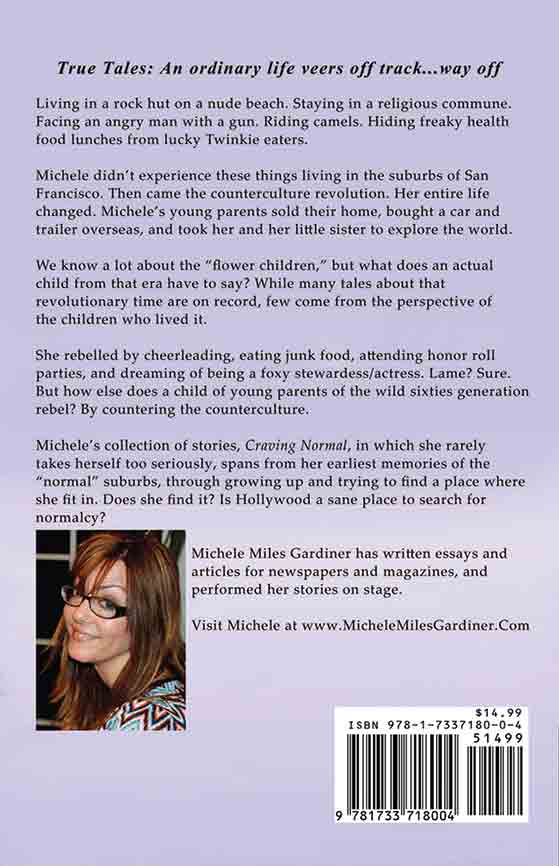
One night in 2010, time-warped and the earth tilted the second our old friend Marv didn’t heed my husband Ian’s advice. It was the point of no return when Rod Serling should’ve stepped in to warn us:
“You’re traveling through another dimension, a dimension not only of sight and sound but of mind. A journey into a wondrous land whose boundaries are that of imagination. That’s the signpost up ahead – your next stop, the Twilight Zone.”
As Marv drove from the Valley on the 101, Ian said, “Whatever you do, Marv, don’t take the Highland exit.” Everyone knows the evening Hollywood Bowl traffic will suck you in, keep you trapped until it spits you out into Hollywood, forever altered – and not in a good way. But Marv didn’t listen. He ignored Ian’s sage advice, drove onto the Highland exit, and plunged us into the hellish pit of metal, glaring headlights, and helpless drivers who sat in a mass stupor.
But we didn’t realize things are askew just yet.
“Doe a deer, a female deer…” Marv’s girlfriend, Lisa, and I, both sitting in the back seat, began singing (after seeing the Hollywood Bowl billboard’s announcement of a Sound of Music sing-a-long), completely unaware we were hurtling into another dimension, we naively continued singing more songs from Sound of Music, “High on a hill was a lonely goat herd… Lay ee odl lay ee odl lay hee hoo…”
After an inconceivable amount of time–minutes? Hours? A few decades? Marv’s car was spit from Highland out onto Sunset Boulevard. We drove toward El Compadre, craving Mexican food and thirsting for margaritas. We passed the purple neon and blinking lights of the Seventh Veil and its “Live Nude Girls,” and The Saharan Motel, where I stayed my first night in LA.
Our starving foursome entered El Compadre. Musicians were playing mariachi music. People were smiling, laughing, dipping crispy tortilla chips into chunky red salsa, and swigging margaritas into their happy faces. We pushed through the joyous crowd. They all looked so happy with their chip-eating and margarita-swigging, we wanted to join them. But we learned the wait could be an hour, so we drove somewhere else.
That’s when we fell deeper into a dimension I never imagined would be possible to re-visit.
Like zombies, we drove down Melrose toward our destination. As if we didn’t live in a city with a wide array of Mexican restaurants, as if we didn’t have the power to make choices, we drove on. Nearing Paramount Studios, Marv, a drummer, told stories of recording at Studio 55.
We parked across from where Studio 55 once existed. Closed for years, Studio 55 was the reason we drove to Lucy’s El Adobe. It was where Marv, Ian, and many recording artists would go to grab meals on breaks from recording.
But that was back in the ‘70s.
“This is where Jerry Brown and Linda Ronstadt would have their tryst,” Marv said, opening the door to Lucy’s.
We walked into a room with gloppy amber-colored lights stuck to dingy walls, walls littered with bad Mexican motifs. Every other inch of the dingy walls was covered with photos of celebrities in frames. I did a double-take. Is that Suzanne Sommers, as Chrissy Snow from Three’s Company, smiling down at me with a ponytail stuck to one side of her head?
While none of us seemed impressed with the dated and slightly decrepit atmosphere, we tried to find a table. One side of the room was too dark. The other side had glaring light in one corner and was dim in another. Unlike El Compadre, there was no music and no laughter. Some people were seated, but they didn’t seem all that happy about it.
Yet we stayed.
We were seated in a room with a too-bright TV in the corner and a very long table of people who seemed to have nowhere better to go. So we joined them in their misery and took our place at a faux-wood, Formica-topped table.
To my right, over Marv’s shoulder, I couldn’t take my eyes off the bad painting of former California Governor Jerry Brown, circa 1978. He was in profile and seemed to have an eagle flying out of his nose. But I was starving and thirsty, so I did my best to ignore it.
Marv mentioned again, “Yeah, this is where Jerry Brown and Linda Ronstadt would have their tryst.”
“Marv, do you have some sort of quota to say the word tryst, tonight?” I asked.
Starving and thirsty, we still all managed to laugh.
Finally, a busboy gave us chips and salsa. The watery red salsa was accompanied by a sorry little wooden bowl, the size of a baby’s palm, with about sixteen chips sitting in it. Not great at math, even I calculated that’s only four chips per person.
We each took turns grabbing our first chip. I bit into mine. “Ewww. It’s cold and stale. And what’s with serving them in such a puny bowl? Haven’t they updated since the ‘70s? Don’t they know we now expect bucket-sized drinks and huge baskets of chips?”
Lisa nodded. Ian rolled his eyes. Marv quoted Woody Allen from Annie Hall: “Two elderly women are at a Catskill mountain resort, and one of ’em says, ‘Boy, the food at this the food at this place is really terrible.’ The other one says, “Yeah, I know–and such small portions.”
With scenes from Annie Hall drifting through my mind, I zoned in on the teeny tortilla chip bowl and realized that the bowl is exactly the same type my mom had back when I was a kid… in the 1970s. I looked up and stared at Jerry Brown and the eagle flying out of his nose. I shook my head. What decade are we in?
Now Lisa looked frustrated as she stared at the tiny wooden bowl. “This isn’t right. The chips are gone, but we still have lots of salsa.”
We all nodded. It was wrong. But I thought our waiter wouldn’t be bringing us chips very soon, because he probably thought, “Hey, why should I give these people decent service? I cater to the hoity-toity elite like Jerry Brown, Chrissy from Three’s Company, the kid from HR Puff-n-Stuff, the Breck Girl, Mr. Whipple from the Charmin toilet paper commercial…”

Finally, we got more stale chips. But we were then out of salsa. It must’ve evaporated since the time the waiter last visited.
Lisa was not happy. “Now we have chips, but no salsa.”
We all nodded. This was wrong. The chip-to-salsa ratio was askew. We were in a bad cycle.
The waiter may have brought us salsa, but then we’d have no chips; then he might have found time to get us some chips, but then we’d have had no salsa. Lisa was right.
That’s when I had an epiphany: Of course the chip-to-salsa ratio was out of whack. The entire night was off-kilter. Couldn’t everyone see what happened? We’d plummeted back into 1978 when Jerry Brown was Governor! That would explain the artwork and dated Hollywood “celebrities” on the walls.
We finally got our puny (which were supposed to be large but only according to a long-gone era’s measurement), strangely perfumey margaritas. The below-average tasting drinks confirmed my discovery of our time travel error. The only way this restaurant could still be opened in the present era of bigger, better, more choices and online restaurant review sites – it was still 1978. There’s no other explanation for how this place could survive.
The waiter never brought the guacamole Marv ordered and my chicken mole enchiladas tasted like they’d been drenched in chocolate syrup.
Who else would accept food and service that bad? The only people who would return again and again to this place are people who’ve sat in gas lines due to the oil crisis, people who’ve worn polyester pantsuits on a hot LA day, people who’ve hustled to disco music, people who laugh at Three’s Company and listen to their eight-track tapes of Abba and Captain and Tennille. Those are the people who don’t complain when served sixteen stale tortilla chips. They don’t know any better. They don’t have online review sites like Yelp. Heck, for them, the personal computer didn’t even exist yet.
I kept this information to myself, that we’d been hurtled deep into the darkness of the disco-era doldrums.
Lisa thought the only thing off-kilter was the chip-to-salsa ratio. I didn’t want to panic her any further. Ian, Lisa, and Marv only knew the night was out of balance, and it all felt wrong as if something was amiss, but they couldn’t figure out what was wrong.
We couldn’t wait to get out of that place, debated what sort of tip to leave, and scampered out as quickly as possible.
Would we ever return to the year 2010, when people are served large baskets of tortilla chips, where little joyless crap-hole restaurants could never survive on their reputation from over thirty years ago?
I started to worry. Will I go home and find someone’s Ford Pinto parked in my driveway? Will it be my home at all? Or will I have to revisit 8th grade in Northern California, wearing Ditto Jeans, my lips smeared with Bonne Bell strawberry gloss as I hum “Dream Weaver” to myself on my way to school… dreaming about my future? Please, no!
Once we left the restaurant, I surveyed the street outside—as we left it. We were back in 2010. We wouldn’t be driving home in an AMC Pacer. We’d made it back to the future – to the present. Never again would Lisa have to suffer the outrage of chips without salsa, because we, the people of the 2000s, had learned to put chips in large baskets. We were back to where computers have come far beyond Pong! Never again would I take our present day for granted. I was done dabbling in time travel even if there was some great music back then and Robert Plant, Roger Daltrey, and John Travolta were all hot.
Maybe I hallucinated the entire time warp thing and got carried away with all the Jerry Brown art and musty Mexican motif.
Once home, I was excited to be back in my very own place, ran to my computer, and went online to post a review of Lucy’s El Adobe: “Just don’t!”
Standing behind me, as I typed my last “!” was Rod Serling:
“If you think it’s possible to return to the past without any consequences, think again. Once it’s done, everything you know will go out of balance. This is the Twilight Zone.”
Dedicated to our much loved and missed friend, Marvin Kanarek, an artist, drummer, architect, and lover of stories. This goofy tale made him giggle.

I gave myself the word prompt “pickle” and wrote this wacky, fictional thing: “That damned Peaches!”
I blame Peaches. If only Mom didn’t have to leave town for an emergency business trip. Because Dad–or as Mom called him, “That Damned Man!”–wasn’t around, Mom asked Uncle Dwayne if he could watch me. Her name for her brother Dwayne, “Drunken loser.” I was ten, so I told Mom I could take care of myself. I’d just heat up a Swanson frozen dinner, crawl in her warm waterbed and watch my favorite shows: “The Brady Bunch,” “The Partridge Family,” and even the show Mom hated, “Love, American Style.”
Mom rolled her eyes at me and dialed Uncle Dwayne.
A woman with a bubble of red hair opened Uncle Dwayne’s door. “You’re just darling! I’m Peaches!”
She pulled me so close I had to struggle to find air in her Jean Naté-doused cleavage. I knew that smell well from trying it at Woolworth’s and accidentally spilling the entire bottle. The stink made me gag. But I tried not to gag because that would be rude. She seemed nice.
Uncle Dwayne ignored me all night. But I liked Peaches. She taught me how to tease my hair the way she learned when she danced in Vegas. She agreed David Cassidy had amazing dimples and that it really would be great to ride in his colorful bus–but only with him and not with those other Partridges.


“If the bus is rockin’…” Peaches elbowed me and wiggled her eyebrows. “Know what I mean?”
I laughed. No, I didn’t.
In the morning, Peaches let me watch “Soul Train” on Uncle Dwayne’s TV, and she even poured me some coffee. I pretended I liked it, even if I didn’t. But I did like being treated like a grown-up. Mom always acted as if I would become crazed if I had a few sips of caffeine. How silly, I thought, as I drummed my fingers on the breakfast table and tried to stop my knees from shaking.

I needed something in my stomach. Peaches scoured Uncle Dwayne’s fridge to find something that resembled breakfast.
“Dwayne? Doncha got nothin’ in this ice box for the kid?” Peaches yelled, and then reached deep inside the refrigerator. Her butt, in pink polyester slacks, wriggled around as she dug inside. “Sardines, mustard, something green that shouldn’t be–I mean, really! What’re you a cave man?”
Peaches finally managed to scrape together my breakfast: a bowl of tutti-frutti ice cream. She said, “At least it’s got fruit.” So I ate that with some slices of pimento loaf on rye crackers and pickles. She also gave me Uncle Dwayne’s beer stein, his special engraved one that said “Brewski,” full of orange juice.
I lapped up a few spoonfuls of the tutti-frutti ice cream and nibbled a bit of pimento loaf. But those rye crackers smelled weird, sort of like the old guy in my apartment building who smokes a pipe and stares at me when I ride alone with him in the elevator.
Lucky for me, I liked pickles a lot. And I liked orange juice, too. Plus, I was super hungry. Crunch. Gulp. Crunch. Gulp. I alternated between the pickles and the juice. Until, suddenly, I felt the combination of orange juice acids and bitter coffee colliding and then revolting against the pickles I’d consumed. It was war–and my stomach was the battlefield. My insides churned and groaned. I tried for the bathroom, but…
“Damned kid!” is all Uncle Dwayne said to me the entire time I was there. And he only said that because I threw up all over the new orange shag rug in his den–the place he called his “magic spot,” where he spent his time watching football games, and where he hid out the whole time I stayed over. Now he was on his hands and knees picking out partial bits of pimentos, pickles, and tutti-frutti candied cherries from his luxurious deep shag.
Now, decades later, if I smell pickles I have to cover my mouth and run. And I always think about Peaches. Every time I go to the deli and make a big fuss about my sub sandwich, as in: “Excuse me! I told you I can’t have pickles!” I think of Peaches. Every time I get a burger and have to hold my breath as I return the tainted fast food, I think of Peaches. Every time I walk down the aisle in the grocery store that has pickles or pass the grocery deli and smell them, I think of Peaches.
It’s a tough life. Those cruel neighborhood deli employees avoid helping me and talk behind my back whenever I go to pick up a pound of turkey. It’s probably because I’m wearing noseplugs, but so what! Didn’t they see Elephant Man or Sybil? We’ve all got problems. Where’s their compassion?
Worst of all, it’s been nearly impossible to find a guy who will vow to never eat pickles. It’s a dating scenario I never saw portrayed on “Love, American Style”: My pickle problem. What I wouldn’t give to have normal dating issues–a date too talkative, too boring, too cheap. I don’t care, as long as he hates pickles.
My future husband can’t even eat them when I’m not around because I’ll smell them on his clothes, on his breath, from hundreds of feet away. Yes, I’ve tried every kind of therapy–hypno, group, and primal scream, just to name a few. Nothing works. I’ve even tried blinders like horses wear along with my nose plugs. But I can smell pickles from ten feet under chlorinated water. I swear, I smelled them while diving in the deep end at a pool party. A party I was invited to simply because the people didn’t know me well. If they only knew…my life is pickle hell!
That damned Peaches!
*I actually LOVE pickles. I have no idea where this came from. But this dancing lady looks pretty happy with her pickle-like dress.

As a delusional and untalented child, I mangled many songs of the 1970s: Olivia Newton-John’s Have you Never Been Mellow; Minnie Riperton’s Loving You, and so many more, including (as I mention in this Los Angeles Daily News piece of mine) Debby Boone’s You Light up My Life.
Yes, it’s true. I sang out in public without shame. See this photo above? I’m dancing and singing, as I often did. And from the big hand gestures, I’m guessing the number I’m assaulting everyone in my vicinity with is Age of Aquarius.
And if I had more room in the Daily News piece, I would’ve included how I, as a Freshman (who should have known better by then), sang Linda Ronstadt’s Blue Bayou to my entire high school. Yep, it was just me singing a capella – standing in the middle of the auditorium during a school rally.
So, yes, I was truly delusional… I say in the past-tense, while typing about my life into cyberspace as if anyone gives a damn. Some things haven’t changed.
The dawning of the Age of Aquarius; yet my lack of talent did NOT dawn on me –
I did NOT sound like Linda –
Jug wine was to the 1970s what Scotch was to the 1950’s Rat Pack crowd; what Martinis were to 1960’s cocktail parties or what Bartles and Jaymes wine coolers were to the 1980s. Yep, jug wine is just as ’70s as mood rings, shag rugs and Pong. The combo just somehow went together – like Sonny & Cher, the Captain & Tennille, Shields and Yarnell… Okay, I think I’ve taken that whole thing too far, haven’t I? (*Don’t know what a mood ring is? See the 1970’s mood ring commercial, bottom of this post).
While going through slides for my book, “Craving Normal,” I discovered a theme in many photos from the ’70s involving my parents and their friends: the ever-present (or nearly always present) jug wine – there it was at house parties, diving days, beach outings, camping trips… and even at a kiddie party at the San Francisco zoo. No wonder whenever I see memories of the 1970s in my head, those bottles always seem to be clanking around there somewhere.
Hey, let’s play find the Jug O’ Wine (I guess the “wine” in each photo might give away the answers, huh?)
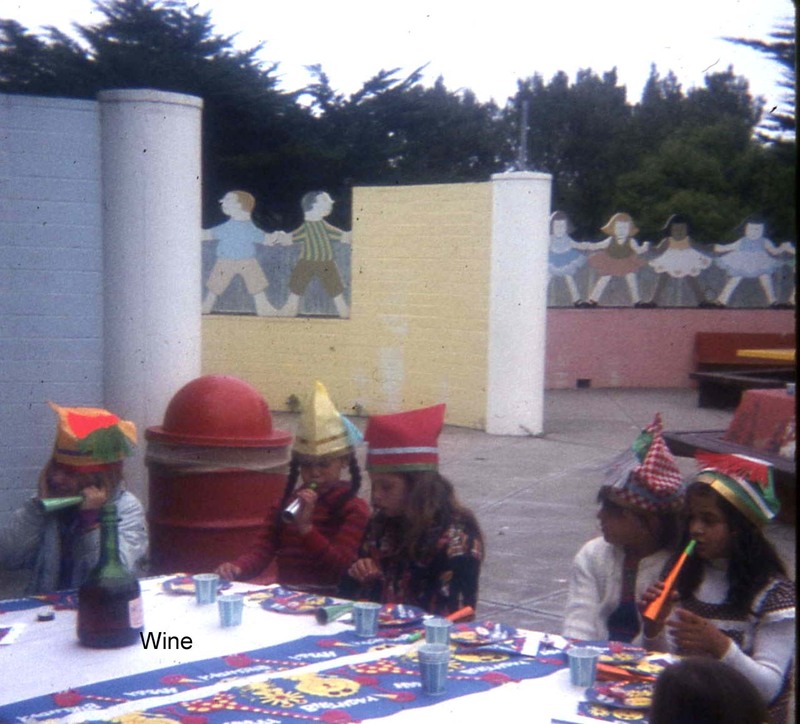
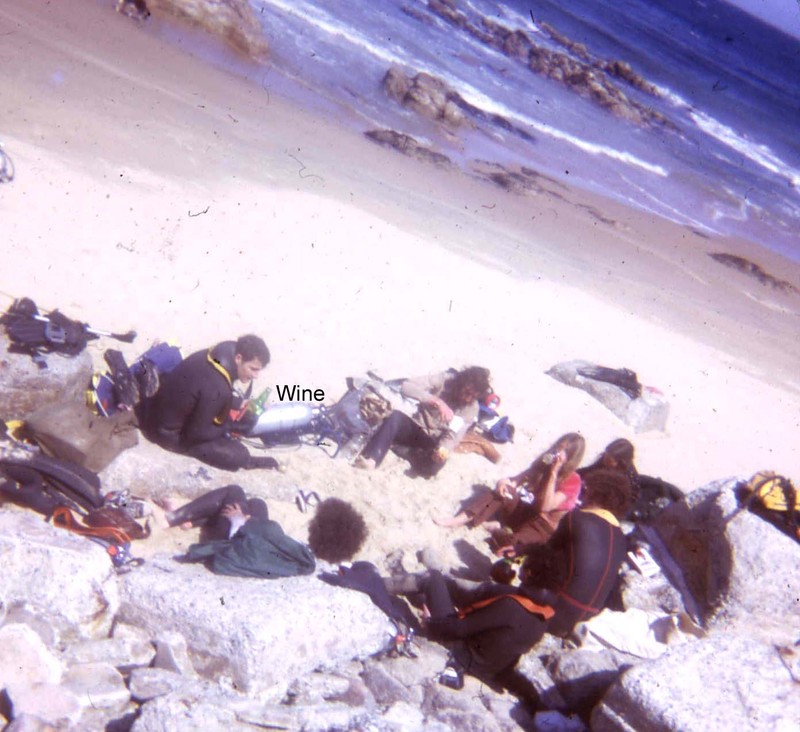
Maybe adults were trying to run away from home as this 1970’s Mateus ad reflects –
Mood rings –
Life experiences, one huge reason I devour memoirs and biographies. Again and again, I’m fascinated by what other people have gone through and how they use those experiences as they’ve grown. Did their bad experiences make them stronger? Or were their easy childhoods a detriment? An advantage?
In my book, “Craving Normal,” (available soon!) I share a story called “My Place in The Sun.” In it, I tell about the summer between 7th and 8th grade where I morphed from a chubby kid with a metal front tooth into a slimmer version of myself with a new white capped tooth. The boys who once made fun of me did a 180. Creeps!“When I returned to school for eighth grade, instead of my old husky-sized jeans and embroidered smock top, I wore Ditto pants that fit my butt just right and a purple satin baseball jacket. Now the boys who once teased me with “Michele Miles, I wish you were miles away,” and taunted me with “Michele, Michele, the Liberty Bell!” smiled and squeaked, “Hi, Michele,” which made me want to scream: “Hey, you idiots! I’m the same girl you teased only a few months ago!” But I ignored them and joined the cheerleading squad.”
Amy Poehler’s “Yes Please” on Amazon.
